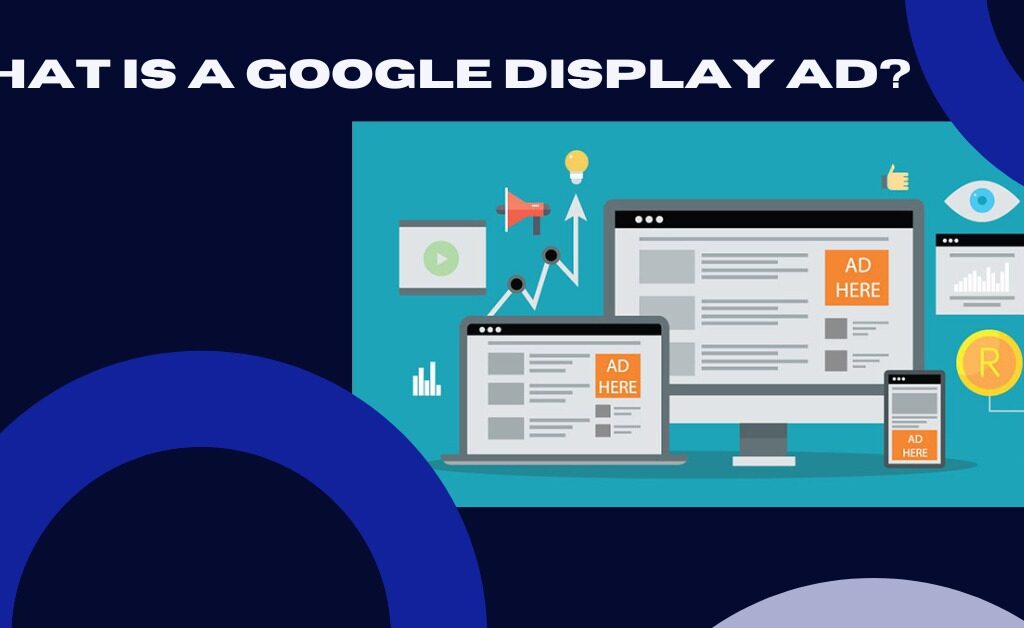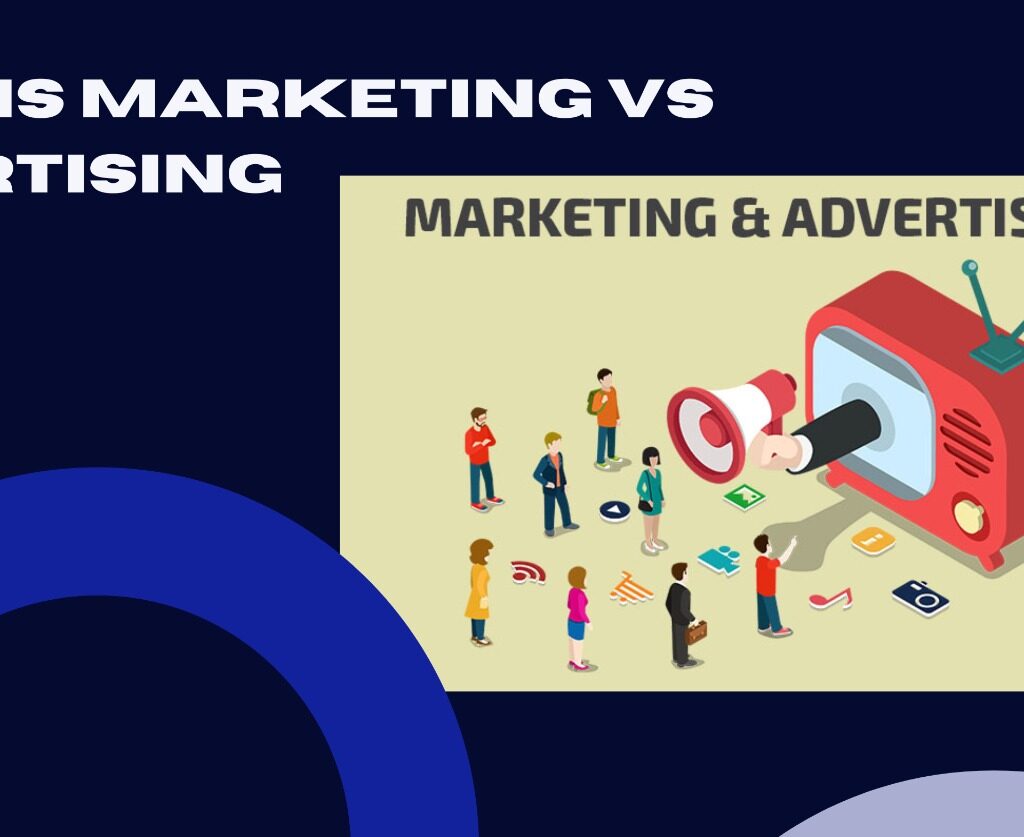Google display ads to users through its network of websites and mobile apps. Advertisers can target their ads to specific audience segments based on location, demographics, interests, and search history.

What is a Google Display Ad?
A Google Display Ad is a type of online advertising that appears on websites and mobile apps in the Google Display Network. It is a visual advertisement created that managed using Google Ads AdWords), typically including images, videos, and text.

Display advertising aims to increase brand awareness and drive conversions through targeted, engaging, and visually appealing ads.
Google Display Ads can appear in various sizes and formats and be placed on websites and mobile apps across the Google Display Network .
What is marketing vs. advertising
Marketing and advertising are two interrelated but distinct concepts in business. It involves researching, promoting, selling, and distributing a product or service.

Marketing encompasses various activities, including market research, product development, branding, pricing, distribution, customer service, and public relations.
Advertising, on the other hand, is one of the tools that companies use to execute their marketing strategies.
It is a paid form of communication that aims to persuade an audience to purchase .Advertising can take various forms
advertising that including TV commercials, print ads, online ads, and billboards.
Ways That Google Display Ads Grow Marketing Results for Advertisers

Google Display Ads can grow marketing results for advertisers in several ways, including:
Targeted advertising:
Google Display Ads can be targeted to specific audience segments based on factors such as location, demographics, interests, and search history.
This targeted advertising can increase the relevance of the ads to the users, which can result in higher engagement rates and conversions.
Wide reach:
The Google Display Network includes over 2 million websites and mobile apps, providing advertisers with a wide reach to a large and diverse audience.
Measurement and optimization:
Advertisers can use Google Ads to track the performance of their campaigns, optimize their ad targeting, and measure the impact on their business goals. This data-driven approach can lead to more effective advertising and growth in marketing results.
Engaging and visually appealing ads:
Google Display Ads can be designed to be visually appealing and engaging, which can help increase brand awareness and drive conversions.
Cost-effective:
Google Display Ads operates on a pay-per-click model, meaning that advertisers only pay when users click on their ad.
This cost-effective advertising model can help advertisers reach their target audience without breaking the bank.
Responsive Display Ads Are Easy to Create and Run at Scale with a Single Ad and Asset?
Responsive Display Ads are a type of Google Display Ad that can be created and run at scale with a single ad and asset. These ads automatically adjust their size, appearance, and format to fit the available ad space on the Google Display Network.
This means that advertisers only need to provide Google with a few assets, such as images, headlines, and descriptions,
Google will automatically generate different versions of the ad to fit different sizes and formats. This can save time and effort and help advertisers reach their target audience cost-effectively and efficiently.
Responsive Display Ads Optimize with Machine Learning.
Yes, that’s correct. Responsive Display Ads are optimized using Google’s machine learning technology. Google uses machine learning algorithms to analyze historical ad performance data and optimize the ad’s size, appearance, and format to maximize its performance.
The algorithms consider various factors, such as audience engagement, the available ad space. The device and platform used, to determine the best-performing ad format and size for each impression.
while Google’s algorithms handle the optimization, saving time and effort and helping to drive better results for their advertising campaigns.
You Can Reach More Customers with Responsive Display Ads.
Yes, that’s correct. Responsive Display Ads allow advertisers to reach more customers by making it easier to run advertising campaigns at scale.
This wide reach can help advertisers connect with their target audience across multiple devices and platforms, including desktop and mobile devices, without creating separate ads for each.
Responsive display ads can target specific audience segments based on location, demographics, interests, and search history.
This targeted advertising, combined with the wide reach of the Google Display Network, can help advertisers connect with more customers.
Diverse Types Of Google Display Ads
Yes, there are several types of Google Display Ads, including:
Responsive Display Ads:
These ads automatically adjust their size, appearance, and format to fit the available ad space on the Google Display Network.
They are created with a single ad and set of assets and optimized using Google’s machine-learning technology.
Image Ads:
These ads consist of a static or animated image accompanied by a headline and description. Image ads can promote products, services, or brand awareness.
Video Ads:
These ads consist of a video accompanied by a headline and description. Video ads can showcase products, services, or brand storytelling.
Lightbox Ads:
These interactive ads allow users to expand and explore the ad content, including images, videos, and product information.
Carousel Ads:
These ads allow advertisers to display multiple images and/or videos in a single ad unit, allowing users to swipe through the images to see more content.
Gmail Sponsored Promotions:
These ads appear in a user’s Gmail inbox, allowing advertisers to reach users in a new and engaging way.
the allowing advertisers to reach users with relevant and engaging content.
Responsive Display Ads
Responsive Display Ads are a type of Google Display Ad that automatically adjust their size, appearance, fit the available ad space on the Google Display Network.
These ads are created with a single ad and set of assets that can including images, headlines, and descriptions, and optimized .
Responsive Display Ads are designed to provide a flexible and effective way for advertisers to reach their target audience across multiple devices and platforms, including desktop and mobile devices.
Uploaded Image Ads
Uploaded Image Ads are a type of Google Display Ad that consist of a static or animated image accompanied by a headline and description.
With uploaded image ads, advertisers can choose a specific image to be used in the ad, along with a headline and description.
Uploaded Image Ads can target specific audience segments based on location, demographics, interests, and search history, allowing advertisers to reach the right audience with the right message.
By using uploaded image ads, advertisers can connect with their target audience and drive results for their advertising campaigns.
Video Ads
Video Ads are a type of Google Display Ad that consist of a video accompanied by a headline and description. These ads can showcase products, services, or brand storytelling and are designed to provide a highly engaging and memorable way for advertisers to reach their target audience.
With Video Ads, advertisers can upload a video to be used in the ad, along with a headline and description.

Video Ads can be targeted to specific audience segments based on location, demographics, interests, and search history.
video ads that allowing advertisers to reach the right audience with the right message. Using Video Ads, advertisers can connect with their target audience and drive results for their advertising campaigns.
Gmail Ads
These ads allow advertisers to reach users in a new and engaging way by delivering targeted content directly.
Gmail Ads consist of a headline, description, and image and are designed to be eye-catching and engaging.
Gmail Ads are highly targeted, allowing advertisers to reach specific audience segments based on location, demographics, interests, and search history.
This allows advertisers to reach the right audience with the right message and to drive better results .
Using Gmail Ads, advertisers can reach users in a new and engaging way, build brand awareness, drive traffic to their website.
Performance Measuring
Performance measurement is an important aspect of Google Display Ads, as it helps advertisers understand the effectiveness of their campaigns.
Google provides a variety of tools and metrics to help advertisers measure the performance of their Display Ads, including:
- Impressions: The number of times your ad has been displayed to users.
- Clicks: The number of times users have clicked on your ad.
- Click-Through Rate :
- The ratio of clicks to impressions is calculated as clicks divided by impressions. CTR is a useful metric for measuring users’ engagement with your ad.
- Cost per Click (CPC): The average cost you pay for each click on your ad.
- Cost per Conversion: The average cost you pay for each conversion generated by your ad.
Final Words on Google Display Ads
Google Display Ads provides a powerful advertising solution for businesses looking to reach a large and diverse audience visually and engagingly.
With various ad formats to choose from, including Responsive Display Ads, Uploaded Image Ads, Video Ads, and Gmail Ads, businesses can find the perfect ad format to meet their specific marketing needs.
This allows them to reach the right audience with the right message and drive better results for their advertising campaigns.
Google’s performance measurement tools and metrics provide advertisers with valuable insights into the effectiveness of their Display Ads, allowing them to optimize their campaigns for better results and achieve their marketing goals more effectively.
Which Factors Should An Advertiser Consider When Deciding on a Bidding Strategy?
When deciding on a bidding strategy for a Google Display Ad campaign, there are several key factors that advertisers should consider, including:
Target Audience:
Understanding your target audience is critical in deciding on a bidding strategy, as different audience segments may require different bids to reach effectively.
Ad Format:
The ad format used can also impact the bid amount, as some ad formats may be more competitive or have higher demand than others.
Budget:
Advertisers must consider their overall budget for the campaign, as bidding too high can quickly consume the budget, while bidding too low can result in poor ad performance.
Competition:
Understanding the level of competition for the target audience and ad format is important in determining the optimal bid amount, as higher competition may require higher bids to reach effectively.
Goals:
The specific goals such as brand awareness, lead generation, or product sales, can also impact the bid amount, as different goals may require different bids to reach effectively.
What is a Key Benefit of Smart Display Campaigns?
The key benefit of Smart Display Campaigns is automation. Smart Display Campaigns use Google’s machine learning technology to automatically create, manage, and optimize Display. Ad campaigns based on the advertiser’s goals and target audience.
This allows advertisers to reach their target audience with the right message and drive better results. the advertising efforts without the need for complex and time-consuming manual optimization.
What’s Provided by Responsive Display Ads?
Responsive Display Ads are provided by Google Ads and are a type of Display Ad that automatically adjust their size, appearance, and format to fit the available ad space on a website or app.
Responsive Display Ads are designed to be highly effective and efficient.
This ads that can allowing advertisers to reach their target audience with a single ad that can be displayed in various sizes and formats, eliminating.
This allows advertisers to reach their target audience with a highly engaging and personalized ad experience.



Add a Comment